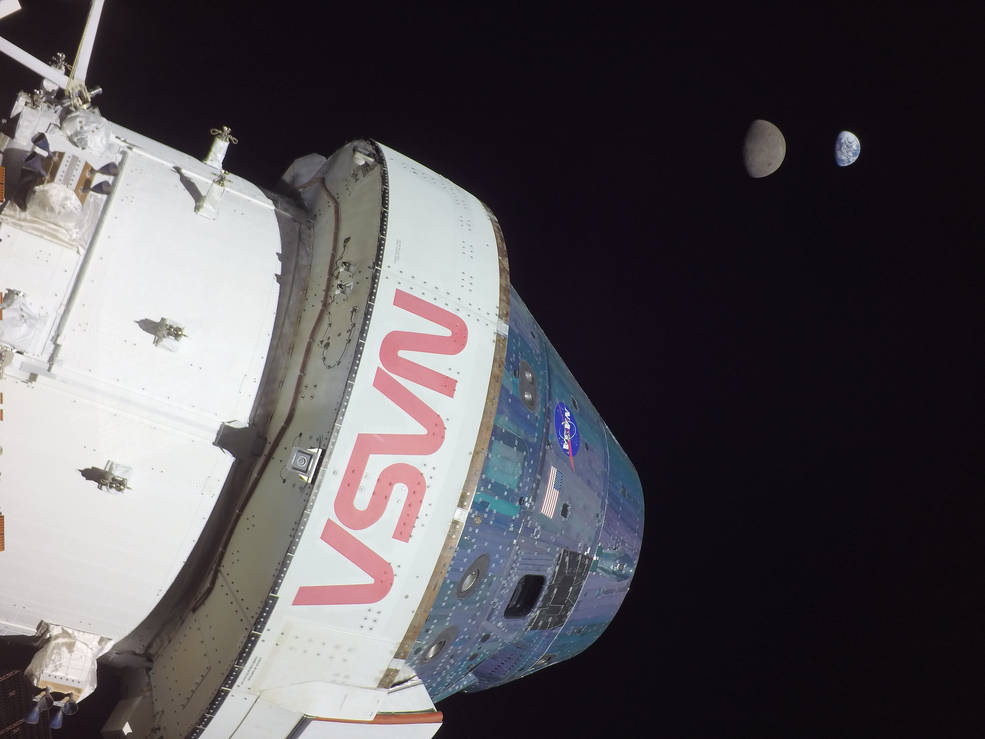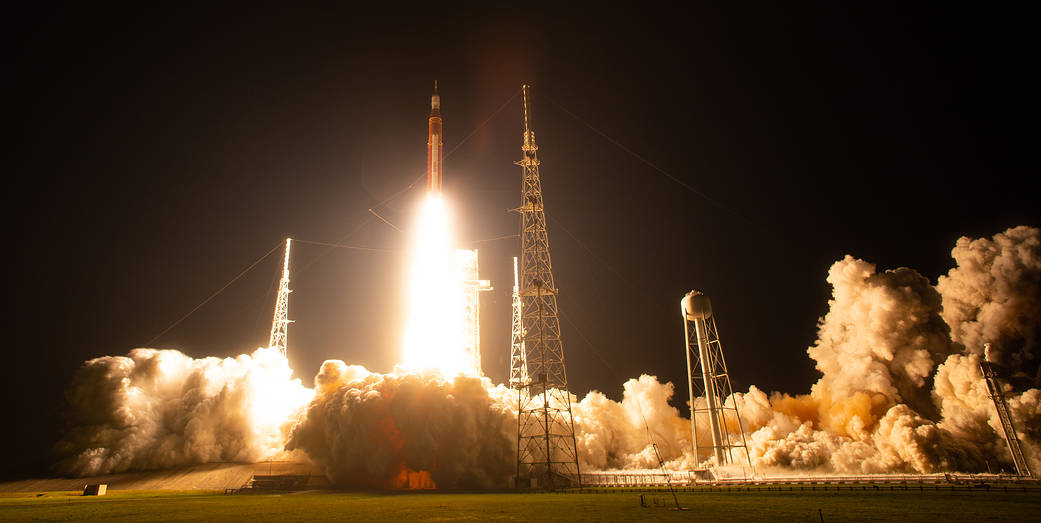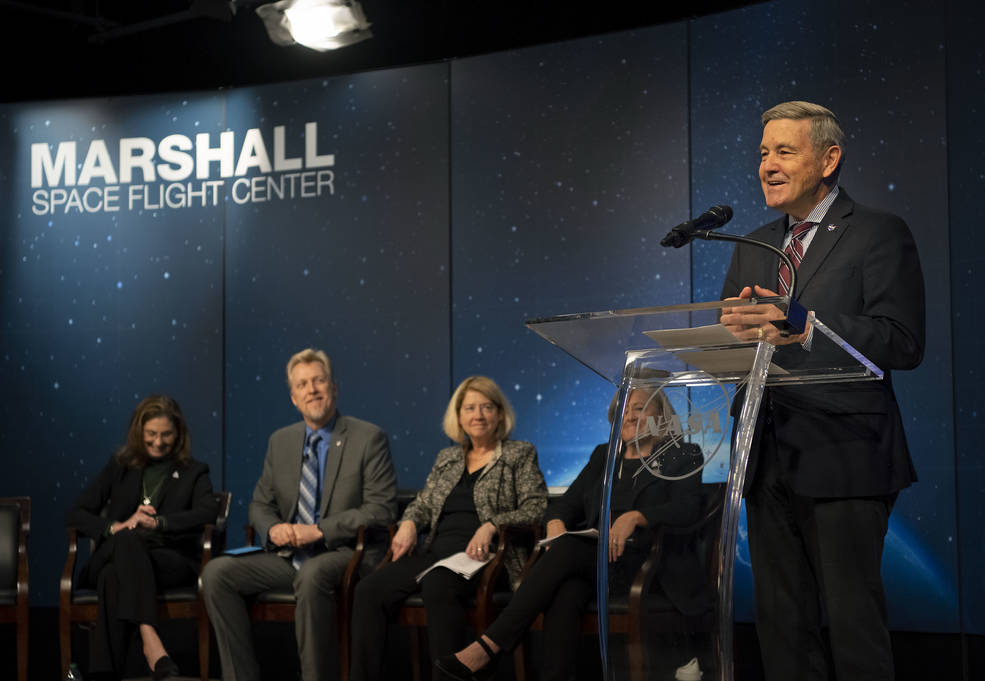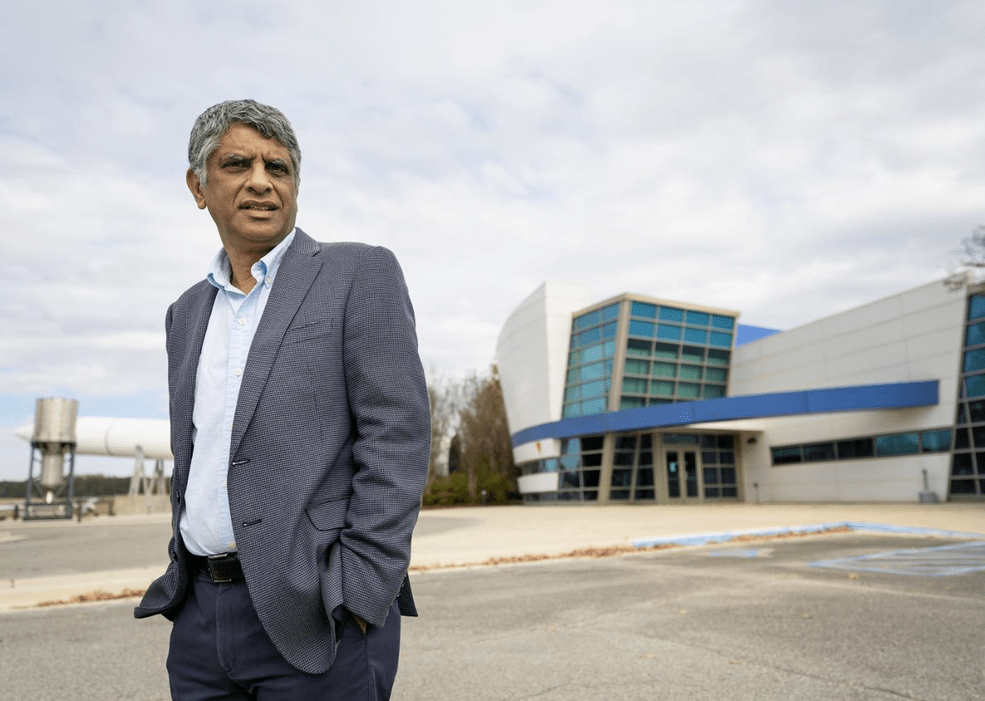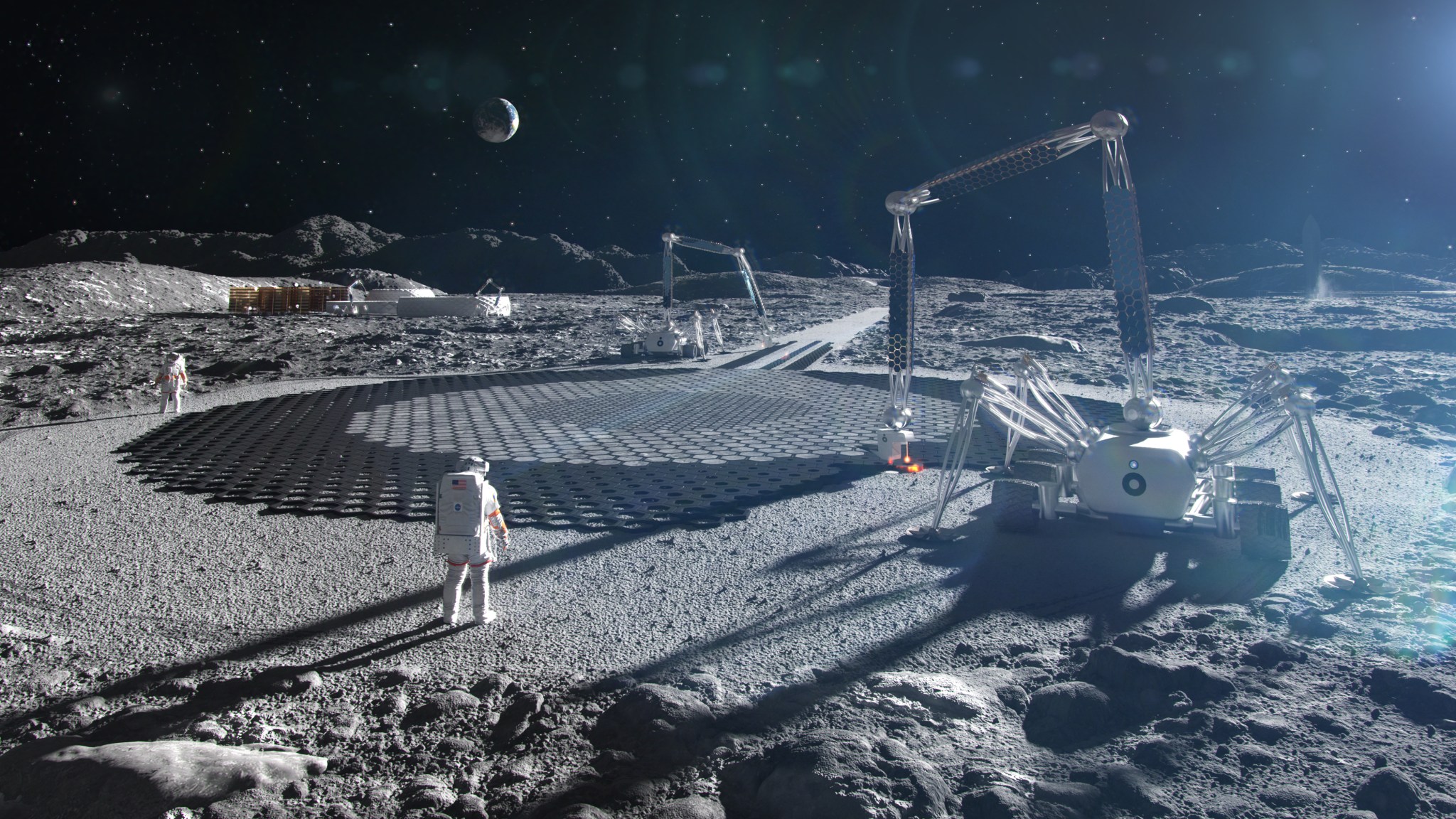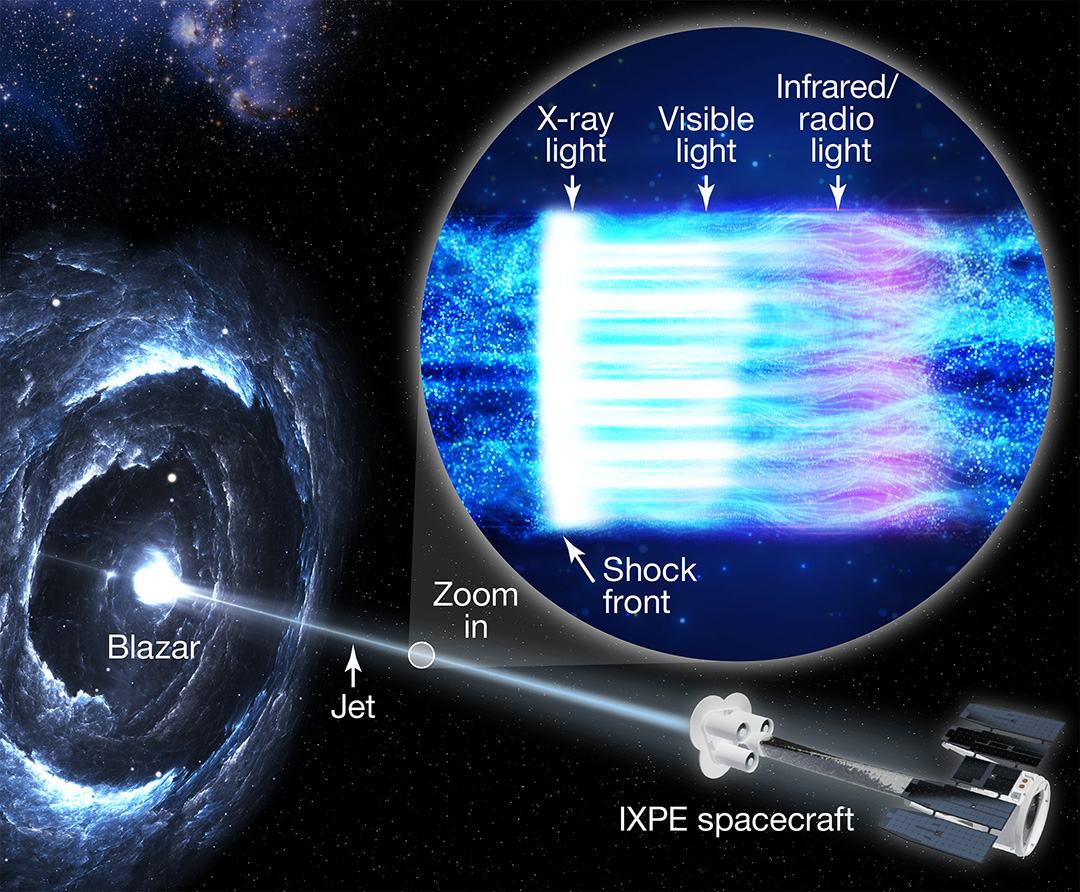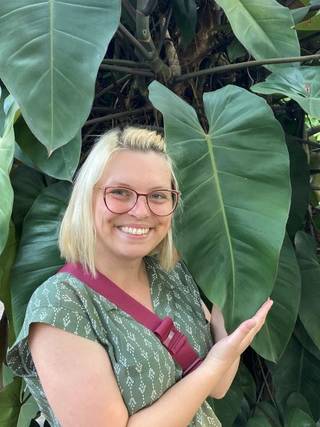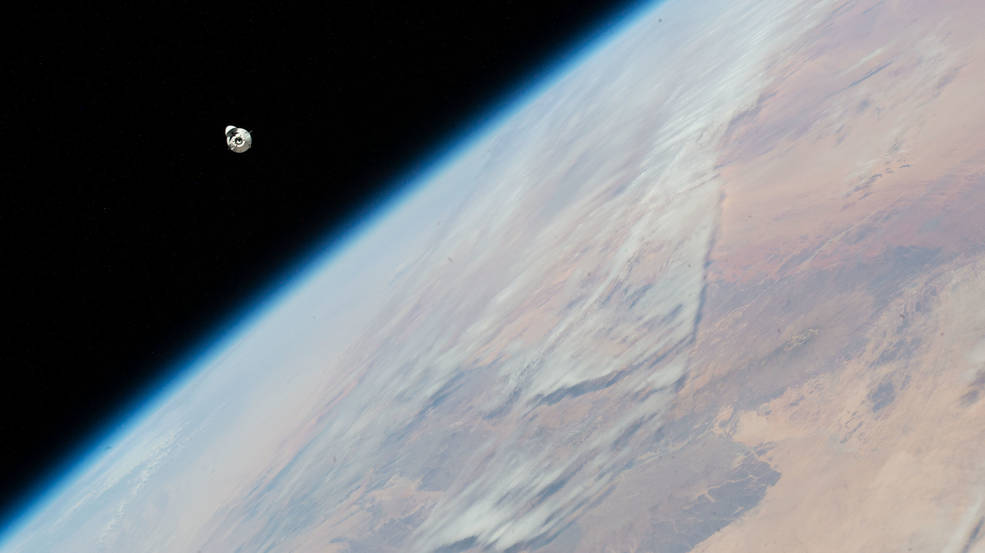The Marshall Star for November 30, 2022.
In This Week’s Star
- Artemis I: Orion Goes the (Max) Distance
- Initial Assessment Shows Excellent Performance for Artemis Moon Rocket
- Town Hall Features Marshall, Agency Leadership
- Take 5 with Dr. Rajiv Doreswamy
- NASA, ICON Advance Lunar Construction Technology for Moon Missions
- IXPE Helps Solve Black Hole Jet Mystery
- Chandra: ‘Listen’ to the Light Echoes From a Black Hole
- Data Scientist Helen Blue Parache Shows Up
- New Experiments, Upcoming Spacewalks Keep Station Crew Busy
Artemis I: Orion Goes the (Max) Distance
NASA’s uncrewed Orion spacecraft reached the farthest distance from Earth it will travel during the Artemis I mission – 268,563 miles from our home planet – just after 3 p.m. CST on Nov. 28. The spacecraft also captured imagery of Earth and the Moon together throughout the day, including of the Moon appearing to eclipse Earth.
Reaching the halfway point of the mission on Flight Day 13 of a 25.5-day mission, the spacecraft remains in healthy condition as it continues its journey in distant retrograde orbit, an approximately six-day leg of its larger mission thousands of miles beyond the Moon.
“Because of the unbelievable can-do spirit, Artemis I has had extraordinary success and has completed a series of history making events,” said NASA Administrator Bill Nelson. “It’s incredible just how smoothly this mission has gone, but this is a test. That’s what we do – we test it and we stress it.”
Engineers had originally planned an orbital maintenance burn Nov. 28 but determined it was not necessary because of Orion’s already precise trajectory in distant retrograde orbit. Based on Orion’s performance, managers are examining adding seven additional test objectives to further characterize the spacecraft’s thermal environment and propulsion system to reduce risk before flying future missions with crew. To date, flight controllers have accomplished or are in the process of completing 37.5% of the test objectives associated with the mission, with many remaining objectives set to be evaluated during entry, descent, splashdown, and recovery.
NASA’s Exploration Ground Systems team and the U.S. Navy are beginning initial operations for recovery of Orion when it splashes down in the Pacific Ocean. The team deployed Nov. 29 for training at sea before returning to shore to make final preparations ahead of splashdown.
Managers also closed out a team formed earlier in the mission to investigate readings associated with the spacecraft’s star trackers after determining the hardware is performing as expected and initially suspect readings are a byproduct of the flight environment.
As of Nov. 28, flight controllers had completed nine of 19 translational burns and exercised the three types of engines on Orion – the main engine, auxiliary thrusters, and reaction control system thrusters. Approximately 5,640 pounds of propellants had been used, which is about 150 pounds fewer than prelaunch expected values. More than 2,000 pounds of margin remain available beyond what teams plan to use for the mission, an increase of more than 120 pounds from prelaunch expected values. So far, teams have already sent more than 2,000 files from the spacecraft to Earth.
For Artemis updates, visit here.
Follow along and track Orion via the Artemis Real-Time Orbit Website, or AROW, and watch live footage from the spacecraft. You can also find the latest images from Orion on the Johnson Space Center Flickr account.
Initial Assessment Shows Excellent Performance for Artemis Moon Rocket
The Space Launch System (SLS) rocket performed with precision, meeting or exceeding all expectations during its debut launch on Artemis I. The world’s most powerful rocket set NASA’s Orion spacecraft on course for a journey beyond the Moon and back, and laying the foundation for the first mission with astronauts on Artemis II and humanity’s return to the lunar surface beginning with Artemis III.
“The first launch of the Space Launch System rocket was simply eye-watering,” said Mike Sarafin, Artemis mission manager. “While our mission with Orion is still underway and we continue to learn over the course of our flight, the rocket’s systems performed as designed and as expected in every case.”
The twin solid rocket booster motors responsible for producing more than 7 million pounds of thrust at liftoff reached their performance target, helping the rocket and spacecraft travel more than 27 miles from its launch site at NASA’s Kennedy Space Center and reaching a speed of about 4,000 mph in just over two minutes before the boosters separated. No issues were reported for any of the booster subsystems including its avionics and thrust vector control system used for steering.
Analysis shows the rocket’s core stage and four RS-25 engines, which burned through the stage’s 735,000 gallons of propellants in just over eight minutes, met every expectation during launch as well as in the final minutes of the countdown before liftoff, when the flight computers and software are in control and many dynamic events involving pressurizing tanks, starting the engines, and igniting the boosters, happen in quick succession.
The mega Moon rocket delivered Orion within about three miles of its planned orbit altitude of 975 by 16 nautical miles, well within the planned range required for the mission, at a speed of approximately 17,500 mph. Analysis shows the rocket’s ascent and in-space software also performed as expected.
The interim cryogenic propulsion stage, the upper stage of the rocket used to perform two burns during the mission to first raise Orion’s orbit and then propel it toward the Moon, performed exactly as planned. The upper stage’s single RL-10 engine, which has powered successful missions to every planet in the solar system and to interstellar space over its more than 50 years in operation, set a single duration burn record, firing for more than 18 minutes to set Orion precisely on its multi-day outbound trek to intercept Earth’s nearest celestial neighbor.
“Performance was off by less than 0.3 percent in all cases across the board,” Sarafin said.
Engineers will continue conducting more detailed analysis of Space Launch System performance over the next several months as the agency continues making progress building and assembling elements for the rocket for Artemis II and beyond.
“I’ve been privileged to lead the team which designed, built, tested and now flown the Space Launch System rocket on its historic first flight, the Artemis I mission,” said John Honeycutt, SLS program manager at NASA’s Marshall Space Flight Center. “With this amazing Moon rocket, we’ve laid the foundation for Artemis and for our long-term presence at the Moon. The performance of the rocket and the team supporting its maiden voyage was simply outstanding.”
The SLS Program is managed by Marshall, and many parts of the rocket were built and tested at Marshall and at NASA’s Michoud Assembly Facility, as well as at Stennis Space Center. Engineers at Marshall supported the Artemis I launch real-time from the center’s SLS Engineering Support Center as well as in the Launch Control Center at Kennedy.
Town Hall Features Marshall, Agency Leadership
By Lane Figueroa
Leaders from across NASA congratulated Marshall Space Flight Center team members for the successful Artemis I launch and looked ahead to the agency’s Moon to Mars strategy during a Nov. 28 town hall.
Addressing the center via the hybrid event, speakers included Marshall Director Jody Singer, NASA Deputy Administrator Pam Melroy, Associate Administrator Bob Cabana, Deputy Associate Administrator for Exploration Systems Development Cathy Koerner, and Director of Space Architecture Kurt “Spuds” Vogel.
After congratulatory remarks from Singer on the Artemis I launch, agency leaders discussed the “why, what, and how” of NASA’s Moon to Mars strategy and the future of those efforts. Melroy began with the “why” and highlighted science, national posture, and inspiration as the pillars of NASA’s contributions to American society.
“The same way I was inspired by Apollo, Artemis is going to create another tidal wave of engineers, scientists, aviators, and explorers who are excited about the future,” Melroy said.
Melroy stressed the importance of “firing on all three pillars” to maintain and foster political resilience and support from all of NASA’s stakeholders. Melroy explained that NASA is creating a blueprint for sustained human presence and exploration throughout the solar system.
Vogel tackled the “what” for NASA’s current strategy by explaining the “tracks” or support groups identified to achieve permanent human presence in space – these included science, infrastructure, transportation and habitation, and operations.
Vogel also mentioned the stakeholder outreach efforts made earlier this year with international partners, U.S academia and industry, and NASA’s workforce. Their diverse and comprehensive feedback and inputs helped to form 63 final objectives and matured strategy for Moon to Mars missions.
Koerner presented on “how” NASA plans to execute these objectives and focused on the science, annual lunar surface missions, Mars missions, and effort to expand partnerships. Koerner explained the agency has been working on future Artemis missions while it simultaneously prepared for the inaugural launch that occurred Nov. 16.
“We’ve got hardware on the shelves waiting to assemble, the spacecraft for Artemis II is in production, and some elements of the spacecraft and the rocket are already at the Kennedy Space Center,” said Koerner. “That’s going to enable us to do the next crewed mission, the test flight that will set up our annual cadence of surface missions to the Moon.”
Cabana emphasized that NASA is developing a “sustainable architecture” that can remain in place no matter the administration, and he also recognized Marshall for its invaluable contributions to the agency.
“Marshall is going to be absolutely critical in playing a key role in developing the future technologies and ensuring that the rockets we fly and missions we execute are successful, just as you’ve done in the past,” Cabana said.
Following their remarks, the leaders took questions. When asked about the difference between the Apollo and Artemis program, Koerner compared the human and technological capabilities of the respective time periods.
“When we go back to the Moon, the Moon is the same, but we are not,” Koerner said. “We are not (the same) from the standpoint of capability to assess the environment, to understand what is happening to the human system when we put humans on the surface, to understand the technologies, and to be able to eventually develop the ability to live off the land.”
Other topics that originated from questions included excitement for scientific discovery that will stem from Moon and Mars missions, symbiotic relationships between NASA and commercial partners, the need for engineers with special skills in propulsion, and Marshall’s role in studying climate change.
For the full scope of topics discussed watch the Town Hall replay here.
Figueroa, a Media Fusion employee, supports Marshall’s Office of Strategic Analysis & Communications.
Take 5 with Dr. Rajiv Doreswamy
By Daniel Boyette
Dr. Rajiv Doreswamy doesn’t have to look deep into the past when choosing the proudest moment of his 34-year NASA career; he’s living his proudest moment in the present.
Doreswamy is manager of the Exploration Transportation and Development Office at NASA’s Marshall Space Flight Center. He and his team have been integral to the success of multiple recent missions.
“We have played a key role in certifying both rockets – SpaceX Falcon 9 and United Launch Alliance Atlas V – for use in the Commercial Crew Program and returning crew transportation to U.S. vehicles from American soil,” said Doreswamy, who began his current role in 2017. “We have completed six crewed missions to the International Space Station. The Orion Launch Abort Team delivered the first qualified system to Kennedy Space Center for Artemis I. We are also playing key roles in Artemis Cross Program Systems Integration as well as defining the architecture for the lunar surface and beyond.”
Question: What are your primary responsibilities as manager of the Exploration Transportation and Development Office?
Doreswamy: I get to manage a fantastic team of project managers, systems engineers, and our support staff as they execute a variety of activities in human spaceflight. Some of the roles we play in the Human Exploration Development & Operations Office include managing the Orion launch abort system and managing the work that Marshall does in certifying rockets for the Commercial Crew Program. We also fill key systems engineering roles for the agency, including on the Artemis Cross Program Systems Engineering and Integration Team and Artemis Campaign Development Systems Engineering Team. Finally, we are working to coordinate the center’s work supporting the Commercial Low-Earth Orbit Destinations Program at Johnson Space Center.
Question: What excites you most about the future of human space exploration and your team’s role it?
Doreswamy: The future of space exploration is going to be more collaborative across government, industry, and academia and may not necessarily be primarily driven by NASA or the U.S. government. Industry will also have new ways of doing business, including public/private partnerships, using commercial services, and other means of achieving our goals. My team has been involved in Commercial Crew for many years and we can bring that expertise and knowledge to new programs and projects, such as Commercial Low-Earth Orbit Destinations. We also have the advantage of experience in all aspects of the program/project lifecycle, from initial formulation in our Artemis Campaign Development and Mars Concept Architecture work to production and operations, such as the Orion launch abort system and Commercial Crew. I think this team will play a key role in the future of space exploration.
Question: What advice do you have for employees early in their NASA career or those in new leadership roles?
Doreswamy: I think everyone would benefit from having a mentor that they trust and will listen to. Having that independent feedback from someone who has been there before is invaluable. As a new NASA employee, learn as much as you can and really master your technical role. That will enhance your reputation and open opportunities for you. As a new leader, I would encourage you to trust your team; they are the experts in what they are asked to do, and they want you to succeed. In any role you have, build your network and learn how to communicate clearly and concisely.
Question: What do you enjoy doing with your time while away from work?
Doreswamy: Travel is one of my favorite things to do. My wife is from Australia, so we have had the chance to travel and explore that part of the world. We have also been lucky enough to visit national parks out west – Yellowstone, Grand Teton, and Rocky Mountain – and hiked in them. I also have an interest in disability awareness and advocacy issues and work with local organizations, such as the Alabama Institute for Deaf and Blind.
Question: You have electrical engineering degrees from both the University of Alabama (doctorate) and Auburn University (master’s). Do co-workers ever give you a hard time about your allegiance in the rivalry?
Doreswamy: I also have a degree (bachelor’s in electrical engineering) from the University of Florida! I get a hard time from many folks, but I’m almost guaranteed that at least one of my teams will be successful on Saturdays! I’m very lucky to have attended each of those universities and I’m not going to choose one as my favorite. I have great memories and great friends from each of them.
Boyette supports Marshall’s Office of Strategic Analysis & Communications.
NASA, ICON Advance Lunar Construction Technology for Moon Missions
As NASA plans for long-term human exploration of the Moon under Artemis, new technologies are required to meet the unique challenges of living and working on another world.
NASA has awarded ICON, located in Austin, Texas, a contract to develop construction technologies that could help build infrastructure such as landing pads, habitats, and roads on the lunar surface.
“In order to explore other worlds, we need innovative new technologies adapted to those environments and our exploration needs,” said Niki Werkheiser, director of technology maturation in NASA’s Space Technology Mission Directorate (STMD). “Pushing this development forward with our commercial partners will create the capabilities we need for future missions.”
The award is a continuation of ICON’s work under a Small Business Innovation Research (SBIR) dual-use contract with the U.S. Air Force, partly funded by NASA. The new NASA SBIR Phase III award will support the development of ICON’s Olympus construction system, which is designed to use local resources on the Moon and Mars as building materials. The contract runs through 2028 and has a value of $57.2 million.
ICON will work with NASA’s Marshall Space Flight Center under STMD’s Moon to Mars Planetary Autonomous Construction Technologies (MMPACT) project. NASA is partnering with industry, government, and academic institutions under the MMPACT project.
The award will build on ICON’s commercial activities and other work with NASA.
ICON 3D printed a 1,700-square-foot simulated Martian habitat, called Mars Dune Alpha, that will be used during NASA’s Crew Health and Performance Analog, or CHAPEA, analog mission starting in 2023.
ICON also competed in NASA’s 3D Printed Habitat Challenge, a part of NASA’s Centennial Challenges program which is managed at Marshall. The company partnered with the Colorado School of Mines in Golden, and the team won a prize for 3D printing a structure sample that was tested for its ability to hold a seal, for strength, and for durability in temperature extremes.
MMPACT is part of the Game Changing Development program within NASA’s STMD.
IXPE Helps Solve Black Hole Jet Mystery
Some of the brightest objects in the sky are called blazars. They consist of a supermassive black hole feeding off material swirling around it in a disk, which can create two powerful jets perpendicular to the disk on each side. A blazar is especially bright because one of its powerful jets of high-speed particles points straight at Earth. For decades, scientists have wondered: How do particles in these jets get accelerated to such high energies?
NASA’s Imaging X-Ray Polarimetry Explorer, or IXPE, has helped astronomers get closer to an answer. In a new study in the journal Nature, authored by a large international collaboration, astronomers find that the best explanation for the particle acceleration is a shock wave within the jet.
“This is a 40-year-old mystery that we’ve solved,” said Yannis Liodakis, lead author of the study and astronomer at FINCA, the Finnish Centre for Astronomy with ESO. “We finally had all of the pieces of the puzzle, and the picture they made was clear.”
Launched Dec. 9, 2021, the Earth-orbiting IXPE satellite, a collaboration between NASA and the Italian Space Agency, provides a special kind of data that has never been accessible from space before. This new data includes the measurement of X-ray light’s polarization, meaning IXPE detects the average direction and intensity of the electric field of light waves that make up X-rays. Information about the electric field orientation in X-ray light, and the extent of polarization, is not accessible to telescopes on Earth because the atmosphere absorbs X-rays from space.
“The first X-ray polarization measurements of this class of sources allowed, for the first time, a direct comparison with the models developed from observing other frequencies of light, from radio to very high-energy gamma rays,” said Immacolata Donnarumma, the project scientist for IXPE at the Italian Space Agency. “IXPE will continue to provide new evidence as the current data is analyzed and additional data is acquired in the future.”
The new study used IXPE to point at Markarian 501, a blazar in the constellation Hercules. This active black hole system sits at the center of a large elliptical galaxy.
IXPE watched Markarian 501 for three days in early March of 2022, and then again two weeks later. During these observations, astronomers used other telescopes in space and on the ground to gather information about the blazar in a wide range of wavelengths of light including radio, optical, and X-ray. While other studies have looked at the polarization of lower-energy light from blazars in the past, this was the first time scientists could get this perspective on a blazar’s X-rays, which are emitted closer to the source of particle acceleration.
“Adding X-ray polarization to our arsenal of radio, infrared, and optical polarization is a game changer,” said Alan Marscher, an astronomer at Boston University who leads the group studying giant black holes with IXPE.
Scientists found that X-ray light is more polarized than optical, which is more polarized than radio. But the direction of the polarized light was the same for all the wavelengths of light observed and was also aligned with the jet’s direction.
After comparing their information with theoretical models, the team of astronomers realized that the data most closely matched a scenario in which a shock wave accelerates the jet particles. A shock wave is generated when something moves faster than the speed of sound of the surrounding material, such as when a supersonic jet flies by in our Earth’s atmosphere.
The study was not designed to investigate the origins of shock waves, which are still mysterious. But scientists hypothesize that a disturbance in the flow of the jet causes a section of it to become supersonic. This could result from high-energy particle collisions within the jet, or from abrupt pressure changes at the jet boundary.
“As the shock wave crosses the region, the magnetic field gets stronger, and energy of particles gets higher,” Marscher said. “The energy comes from the motion energy of the material making the shock wave.”
As particles travel outward, they emit X-rays first because they are extremely energetic. Moving farther outward, through the turbulent region farther from the location of the shock, they start to lose energy, which causes them to emit less-energetic light like optical and then radio waves. This is analogous to how the flow of water becomes more turbulent after it encounters a waterfall – but here, magnetic fields create this turbulence.
Scientists will continue observing the Markarian 501 blazar to see if the polarization changes over time. IXPE will also investigate a broader collection of blazars during its two-year prime mission, exploring more longstanding mysteries about the universe. “It’s part of humanity’s progress toward understanding nature and all of its exoticness,” Marscher said.
IXPE is a collaboration between NASA and the Italian Space Agency with partners and science collaborators in 12 countries. Ball Aerospace, headquartered in Broomfield, Colorado, manages spacecraft operations together with the University of Colorado’s Laboratory for Atmospheric and Space sciences, which operates IXPE for NASA’s Marshall Space Flight Center.
Chandra: ‘Listen’ to the Light Echoes From a Black Hole
One of the surprising features of black holes is that although light (such as radio, visible, and X-rays) cannot escape from them, surrounding material can produce intense bursts of electromagnetic radiation. As they travel outward, these blasts of light can bounce off clouds of gas and dust in space, similar to how light beams from a car’s headlight will scatter off fog.
A new sonification turns these “light echoes” from the black hole called V404 Cygni into sound. Located about 7,800 light-years from Earth, V404 Cygni is a system that contains a black hole, with a mass between five and 10 times the Sun’s, that is pulling material from a companion star in orbit around it. The material is funneled into a disk that encircles the stellar-mass black hole.
This material periodically generates bursts of radiation, including X-rays. As the X-rays travel outward they encounter clouds of gas and dust in between V404 Cygni and Earth and are scattered at various angles. NASA’s Chandra X-ray Observatory and Neil Gehrels Swift Observatory have imaged the X-ray light echoes around V404 Cygni. Because astronomers know exactly how fast light travels and have determined an accurate distance to this system, they can calculate when these eruptions occurred. This data, plus other information, helps astronomers learn more about the dust clouds, including their composition and distances.
The sonification of V404 Cygni translates the X-ray data from both Chandra and Swift into sound. During the sonification, the cursor moves outward from the center of the image in a circle. As it passes through the light echoes detected in X-rays (seen as concentric rings in blue by Chandra and red by Swift in the image), there are tick-like sounds and changes in volume to denote the detection of X-rays and the variations in brightness. To differentiate between the data from the two telescopes, Chandra data is represented by higher-frequency tones while the Swift data is lower. In addition to the X-rays, the image includes optical data from the Digitized Sky Survey that shows background stars. Each star in optical light triggers a musical note. The volume and pitch of the note are determined by the brightness of the star.
More sonifications of astronomical data, as well as additional information on the process, can be found at the “A Universe of Sound” website.
These sonifications were led by the Chandra X-ray Center and included as part of NASA’s Universe of Learning program. The collaboration was driven by visualization scientist Kimberly Arcand, astrophysicist Matt Russo, and musician Andrew Santaguida (both of the SYSTEM Sounds project). NASA’s Marshall Space Flight Center manages the Chandra program. The Smithsonian Astrophysical Observatory’s Chandra X-ray Center controls science from Cambridge Massachusetts and flight operations from Burlington, Massachusetts. NASA’s Universe of Learning materials are based upon work supported by NASA under cooperative agreement award number NNX16AC65A to the Space Telescope Science Institute, working in partnership with Caltech/IPAC, Center for Astrophysics | Harvard & Smithsonian, and the Jet Propulsion Laboratory.
Data Scientist Helen Blue Parache Shows Up
(This is the 10th in a series of profiles on early career scientists in the Earth Science Branch at NASA’s Marshall Space Flight Center.)
By Dauna Coulter
“My mom always says, ‘If you want something, show up – even if you think someone else could do it better, or you’re not ready, or you might not get picked,’” explains data scientist Helen Blue Parache.
Parache “showed up” and is now a data scientist at NASA’s Marshall Space Flight Center.
“I’m lucky to be doing fulfilling work,” she said.
Parache joined the Commercial Smallsat Data Acquisition (CSDA) Program Data Management Team last summer. As operations lead, she supports CSDA’s objective to identify, acquire, and evaluate data from commercial sources that may complement NASA data and further NASA’s Earth science research. Since Oct. 1, when CSDA began distribution of Maxar data, she has led delivery of that data to NASA-funded researchers.
“Maxar is one of the first companies CSDA worked with to evaluate and then acquire their data,” Parache explained. “Researchers use this optical and short wavelength Infrared data to map coral reef ecology, submerged aquatic vegetation (related to blue carbon estimation), risk factors for disease at the household level, and much more.”
Let’s map the winding roads – and waterways – that brought her to this job.
Parache was born in Washington state and grew up mostly in Philadelphia but lived for a while with her family on a 28-foot sailboat near Olympia, Washington, and later Morro Bay, California.
“One of my favorite childhood memories is of when we were sailing at the Puget Sound at night and some harbor porpoises came and swam with us,” said Parache. “You could see their trail of bioluminescence in the water, and then they would pop up above the water at the bow of the boat!”
She earned a bachelor’s in Japanese Studies from Middlebury College in 2014, and then taught English in Japan for two years.
“I moved back to the U.S. in 2016 when I knew I needed a change from teaching English,” she said. “I entered NASA’s Capacity Building Program in 2017 through the DEVELOP program. This program introduced me to remote sensing and applied science, and I was hooked. I transitioned to SERVIR in 2018, where I supported science coordination for the Hindu Kush Himalaya Hub and later served as the SERVIR Amazonia Science coordination lead. I am thrilled about the opportunity to dive deeper into data management in my new position with CSDA.”
She has also found time to have a baby and earn a bachelor’s and a master’s in Earth System Science from the University of Alabama in Huntsville.
Asked what she is most proud of, she said, “Getting my master’s while working full time and having a baby. My son, Antonio, is now almost 2!”
The Parache household also claims Leonard, Eugene, and Odysseus.
“Leonard is a very rude lovebird, Eugene is a very sweet green cheek conure, and Odysseus is the most laid-back dog with the loudest howl,” she said. “I think he’s part Bluetick Coonhound. My husband adopted him before we met.
“Odysseus always begs Leonard and Eugene to throw him some seeds, which they do all the time because they like to watch him play near them. At night if I forget to cover the birds’ cages, they squawk at me to remind me.”
When not spending time in the midst of this menagerie, Parache enjoys camping, biking, knitting, sewing, and table-top games. One of her aspirations is to be a poet.
Her “go to” life philosophy is that growth is more important than perfection.
“I pursued this philosophy through the International Baccalaureate high school program,” said Parache. “It served me well in college and is such an important mindset in the workplace. My natural inclination is to delay delivery of something I’ve been working on until it is 100 percent complete and perfect. But actually it’s so important to get feedback along the way. And often, for others on your team to move forward, 100% complete isn’t necessary.”
Any final thoughts?
“Show up,” answered Parache.
Coulter, a Media Fusion employee, supports Marshall’s Office of Strategic Analysis & Communications.
New Experiments, Upcoming Spacewalks Keep Station Crew Busy
New science experiments delivered aboard a U.S. cargo craft are being activated aboard the International Space Station this week. The Expedition 68 crew is also preparing for upcoming spacewalks in December.
Carrying more than 7,700 pounds of science experiments, crew supplies, and other cargo, the SpaceX Dragon spacecraft launched on the Falcon 9 rocket Nov. 26 from NASA’s Kennedy Space Center, docking Nov. 27.
NASA flight engineers Nicole Mann and Frank Rubio worked together Nov. 29 unloading research samples from the SpaceX Dragon cargo craft. The duo carefully stowed the specimens inside the U.S. Destiny laboratory module ahead of an experiment to observe how microgravity affects the regeneration of skeletal stem cells. Doctors on the ground will later evaluate the samples to understand bone regeneration and possibly improve therapies for bone conditions on Earth and in space.
Flight engineers Josh Cassada of NASA and Koichi Wakata of the Japan Aerospace Exploration Agency also worked throughout Nov. 29, unpacking a variety of cargo from inside Dragon. The duo took turns removing frozen science samples from Dragon and transferring them into science freezers throughout the space station. The new science experiments shipped aboard Dragon will soon be offering new insights into botany, biology, and physics.
The Payload Operations Center at NASA’s Marshall Space Flight Center houses the International Space Station Payload Operations Integration Center.
Wakata also spent some time setting up lights, batteries, and cameras on Extravehicular Mobility Units, or spacesuits, that Cassada and Rubio will wear during a spacewalk planned to begin at 6:25 a.m. CST on Dec. 3. The NASA astronauts will spend about seven hours in their EMUs installing a new roll-out solar array on the station’s starboard truss structure.
The roll-out-solar arrays, also known as International Space Station Roll-Out Solar Arrays, or iROSAs, are currently packed inside the Dragon’s unpressurized trunk. This week, mission controllers on the ground will remotely command the Canadarm2 robotic arm to extract the iROSAs from Dragon then place them on truss structure attachment points. From there, the spacewalkers will retrieve the roll-out solar arrays for the Dec. 3 spacewalk, as well as a second spacewalk planned for Dec. 19, and install them on the station’s starboard and port truss segments.
Commander Sergey Prokopyev from Roscosmos started his day attaching sensors to himself to measure his cardiac activity. Afterward, he replaced water in an Orlan spacesuit’s loops and checked out its water pumps. He and Flight Engineer Dmitri Petelin will conduct a future spacewalk to relocate a radiator from the Rassvet module to the Nauka multipurpose laboratory module. Flight Engineer Anna Kikina will operate the European robotic arm assisting the duo during their spacewalk.
Learn more about station activities by following the space station blog, @space_station and @ISS_Research on Twitter, as well as the ISS Facebook and ISS Instagram accounts.


























